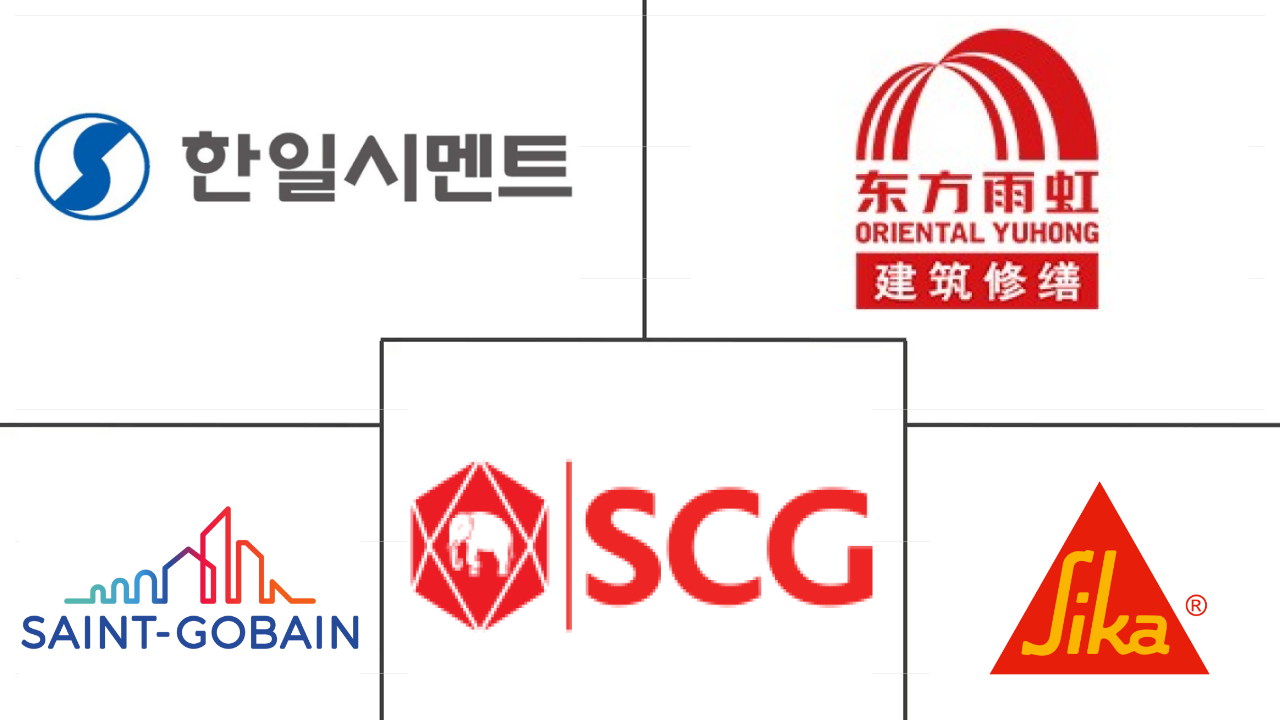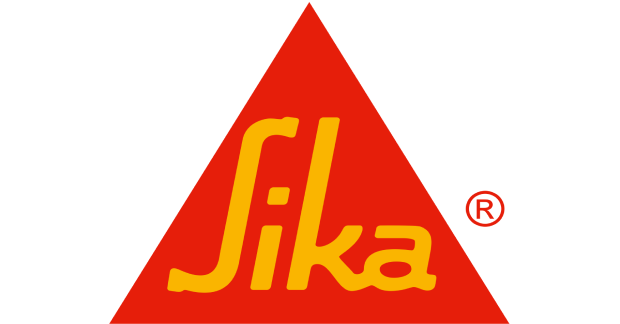Market Size of asia-pacific dry mix mortar Industry
| Icons | Lable | Value |
|---|---|---|
|
|
Study Period | 2018 - 2030 |
|
|
Market Volume (2024) | 143.55 Million Tons |
|
|
Market Volume (2030) | 204.70 Million Tons |
|
|
Largest Share by End Use Sector | Residential |
|
|
CAGR (2024 - 2030) | 6.09 % |
|
|
Largest Share by Country | China |
|
|
Market Concentration | Low |
Major Players |
||

|
||
|
*Disclaimer: Major Players sorted in no particular order |
Asia-Pacific Dry Mix Mortar Market Analysis
The Asia-Pacific Dry Mix Mortar Market size is estimated at 143.55 million Tons in 2024, and is expected to reach 204.70 million Tons by 2030, growing at a CAGR of 6.09% during the forecast period (2024-2030).
143.55 Million
Market Size in 2024 (Tons)
204.70 Million
Market Size in 2030 (Tons)
1.94 %
CAGR (2018-2023)
6.09 %
CAGR (2024-2030)
Largest Market by Application
39.24 %
volume share, Render, 2023
Owing to the growing usage of renders for finishing concrete and cement surfaces, in the residential, industrial, and infrastructure sectors, the segment has dominated the market.
Largest Market by End Use Sector
60.19 %
volume share, Residential, 2023
Due to the increasing usage of dry-mix mortar for applications such as rendering, plastering, waterproofing, tiling, etc. for housing construction, the residential sector holds the largest share.
Largest Market by Country
75.84 %
volume share, China, 2023
With the continuous development of its provinces followed by the construction of huge residential complexes, the demand for dry mix mortar increased, making China the largest consumer in the region.
Fastest Market by Country
6.61 %
Projected CAGR, Indonesia, 2024-2030
Growing infrastructure spending on major sectors in the country such as roads, airports, marine, etc. coupled with growing applications of dry mix mortar, the country is expected to register the fastest growth in the region.
Leading Company
3.31 %
market share, Sika AG, 2022

The company held the largest share in 2022 owing to its large production capacity of around 8.3 million tons of dry mix mortar per year in the region. The company also serves customers across various construction sectors.
Rising demand for housing units is likely to drive the dry mix mortar growth
- By 2022, Asia-Pacific dominated the global dry mix mortar market, accounting for 40.73% of the total share. In 2023, the region's dry mix mortar consumption grew by 4.07% in volume, driven by rising demand from both commercial and residential construction sectors.
- In 2022, the residential sector in Asia-Pacific emerged as the leading consumer of dry mix mortar, comprising 60.34% of the market. Factors such as increasing urbanization, government initiatives, and investments, both domestic and foreign, fueled the region's housing needs. For example, the Government of Indonesia (GOI) aimed to build 1 million housing units by 2025, with the country's total housing demand projected to hit 30 million units. Consequently, the demand for dry mix mortar in the residential sector was forecast to surge from 81.5 million tons in 2023 to 119.7 million tons in 2030.
- The commercial sector in Asia-Pacific was poised to witness the highest growth rate in dry mix mortar consumption, with a CAGR of 7.64% during the forecast period. Anticipated growth in shopping malls, office spaces, and retail centers led to a rise of 178 million sq. ft in commercial floor area in 2025 compared to the previous year. For instance, India's Grade A office market in its top seven cities was projected to expand to 1 billion square feet by 2026 and further to 1.2 billion square feet by 2030. Consequently, the demand for dry mix mortar in the commercial sector was estimated to increase by 13.95 million tons by 2030 compared to 2023.
High demand for dry-mix mortar forecast in Asia-pacific due to rising government investments in the construction sector
- Dry-mix mortar, comprising cement, sand, minerals, and functional additives in precise ratios, finds applications in concrete protection, renovation, rendering, plastering, and waterproofing. Australia's dry-mix mortar market witnessed a significant 17.32% volume growth in 2022 compared to 2021. In the year 2023, Asia-Pacific, driven by robust investments in residential and infrastructure construction, experienced a 4.07% volume growth over the previous year.
- In the year 2022, China held a substantial share of the Asia-Pacific dry-mix mortar market. Despite government-imposed lockdowns, China's infrastructure sector witnessed a 4.29% volume growth between 2021 and 2022. This growth was fueled by a notable increase in transport infrastructure spending, rising from USD 157.6 billion in 2021 to USD 165.6 billion in 2022. Additionally, the residential construction sector in China underwent significant reforms and policy changes, rekindling consumer interest in property purchases. With continued investments and initiatives, the Chinese market experienced a 3.83% volume growth in 2023.
- Indonesia's dry-mix mortar market is set to witness the fastest CAGR of 6.74% in volume during the forecast period. Under the "Capital City Bill," Indonesia embarked on a USD 32 billion project to relocate its capital from Jakarta to Borneo Island by the year 2045. This ambitious endeavor encompasses housing complexes, manufacturing units, and infrastructure, signaling a surge in dry-mix mortar demand.
Asia-Pacific Dry Mix Mortar Industry Segmentation
Commercial, Industrial and Institutional, Infrastructure, Residential are covered as segments by End Use Sector. Concrete Protection and Renovation, Grouts, Insulation and Finishing Systems, Plaster, Render, Tile Adhesive, Water Proofing Slurries are covered as segments by Application. Australia, China, India, Indonesia, Japan, Malaysia, South Korea, Thailand, Vietnam are covered as segments by Country.
- By 2022, Asia-Pacific dominated the global dry mix mortar market, accounting for 40.73% of the total share. In 2023, the region's dry mix mortar consumption grew by 4.07% in volume, driven by rising demand from both commercial and residential construction sectors.
- In 2022, the residential sector in Asia-Pacific emerged as the leading consumer of dry mix mortar, comprising 60.34% of the market. Factors such as increasing urbanization, government initiatives, and investments, both domestic and foreign, fueled the region's housing needs. For example, the Government of Indonesia (GOI) aimed to build 1 million housing units by 2025, with the country's total housing demand projected to hit 30 million units. Consequently, the demand for dry mix mortar in the residential sector was forecast to surge from 81.5 million tons in 2023 to 119.7 million tons in 2030.
- The commercial sector in Asia-Pacific was poised to witness the highest growth rate in dry mix mortar consumption, with a CAGR of 7.64% during the forecast period. Anticipated growth in shopping malls, office spaces, and retail centers led to a rise of 178 million sq. ft in commercial floor area in 2025 compared to the previous year. For instance, India's Grade A office market in its top seven cities was projected to expand to 1 billion square feet by 2026 and further to 1.2 billion square feet by 2030. Consequently, the demand for dry mix mortar in the commercial sector was estimated to increase by 13.95 million tons by 2030 compared to 2023.
| End Use Sector | |
| Commercial | |
| Industrial and Institutional | |
| Infrastructure | |
| Residential |
| Application | |
| Concrete Protection and Renovation | |
| Grouts | |
| Insulation and Finishing Systems | |
| Plaster | |
| Render | |
| Tile Adhesive | |
| Water Proofing Slurries | |
| Other Applications |
| Country | |
| Australia | |
| China | |
| India | |
| Indonesia | |
| Japan | |
| Malaysia | |
| South Korea | |
| Thailand | |
| Vietnam | |
| Rest of Asia-Pacific |
Asia-Pacific Dry Mix Mortar Market Size Summary
The Asia-Pacific dry mix mortar market is experiencing significant growth, driven by increasing demand from both residential and commercial construction sectors. The region has established itself as a dominant force in the global market, with a substantial share attributed to its robust urbanization, government initiatives, and foreign investments. The residential sector, in particular, has been a major consumer, fueled by the need for housing due to rapid urbanization and population growth. Government projects, such as Indonesia's ambitious housing plans, further underscore the rising demand for dry mix mortar in the region. Meanwhile, the commercial sector is poised for the highest growth rate, with expanding shopping malls, office spaces, and retail centers contributing to the increased consumption of dry mix mortar.
The market landscape is characterized by a fragmented structure, with key players like HANIL HOLDINGS CO.,LTD., Oriental Yuhong, Saint-Gobain, SCG, and Sika AG holding a significant portion of the market share. Recent developments, such as strategic acquisitions and product innovations, highlight the dynamic nature of the industry. The Asia-Pacific region's commercial and residential construction sectors are rebounding from previous setbacks, with substantial increases in new floor areas projected. This growth is supported by favorable government policies, increased investments, and a focus on affordable housing, particularly in countries like India. As the region continues to expand its infrastructure and housing capabilities, the demand for dry mix mortar is expected to rise, solidifying its position as a critical component in construction activities.
Asia-Pacific Dry Mix Mortar Market Size - Table of Contents
-
1. MARKET SEGMENTATION (includes market size, forecasts up to 2030 and analysis of growth prospects.)
-
1.1 End Use Sector
-
1.1.1 Commercial
-
1.1.2 Industrial and Institutional
-
1.1.3 Infrastructure
-
1.1.4 Residential
-
-
1.2 Application
-
1.2.1 Concrete Protection and Renovation
-
1.2.2 Grouts
-
1.2.3 Insulation and Finishing Systems
-
1.2.4 Plaster
-
1.2.5 Render
-
1.2.6 Tile Adhesive
-
1.2.7 Water Proofing Slurries
-
1.2.8 Other Applications
-
-
1.3 Country
-
1.3.1 Australia
-
1.3.2 China
-
1.3.3 India
-
1.3.4 Indonesia
-
1.3.5 Japan
-
1.3.6 Malaysia
-
1.3.7 South Korea
-
1.3.8 Thailand
-
1.3.9 Vietnam
-
1.3.10 Rest of Asia-Pacific
-
-
Asia-Pacific Dry Mix Mortar Market Size FAQs
What is the current Asia-Pacific Dry Mix Mortar Market size?
The Asia-Pacific Dry Mix Mortar Market is projected to register a CAGR of 6.09% during the forecast period (2024-2030).
Who are the key players in Asia-Pacific Dry Mix Mortar Market?
HANIL HOLDINGS CO.,LTD., Oriental Yuhong, Saint-Gobain, SCG and Sika AG are the major companies operating in the Asia-Pacific Dry Mix Mortar Market.

